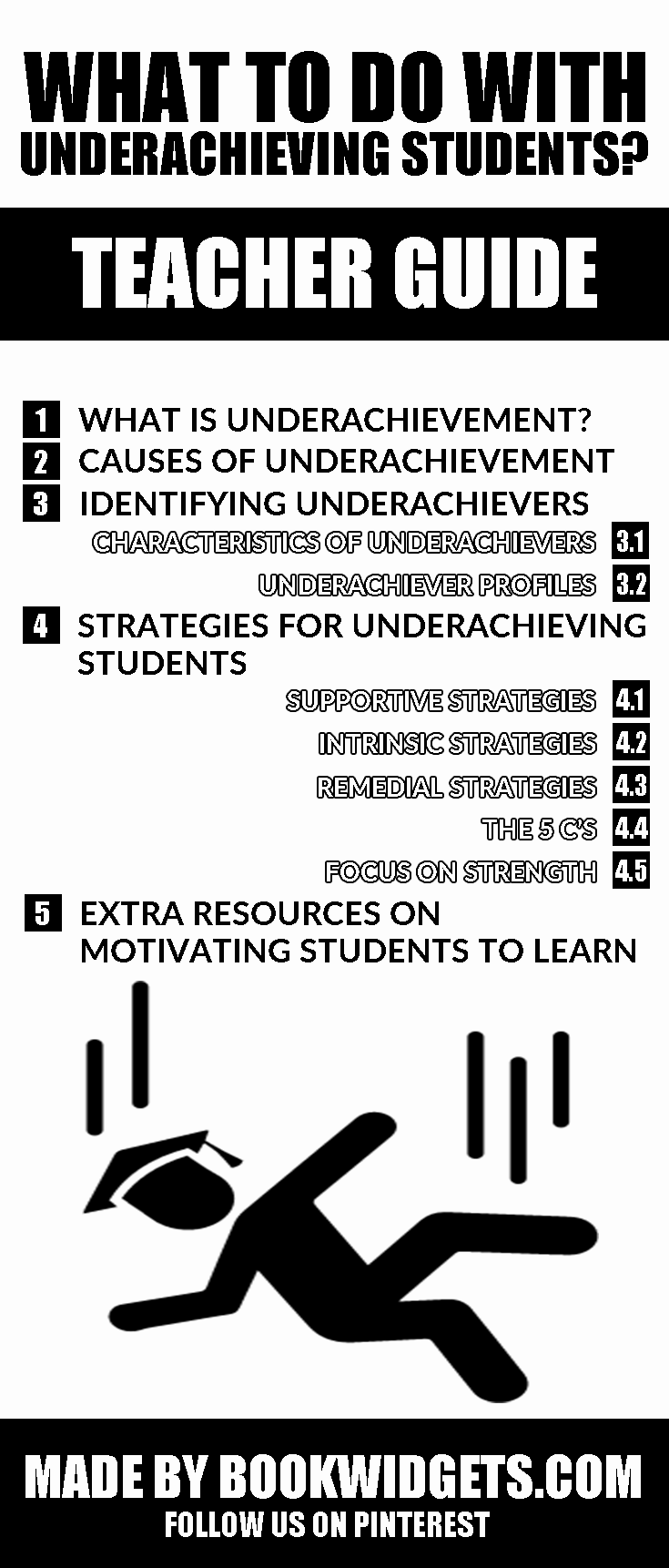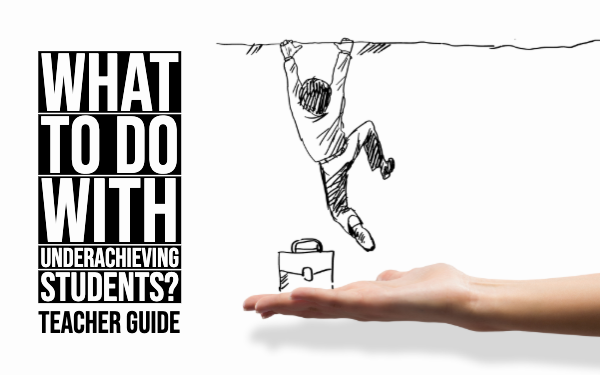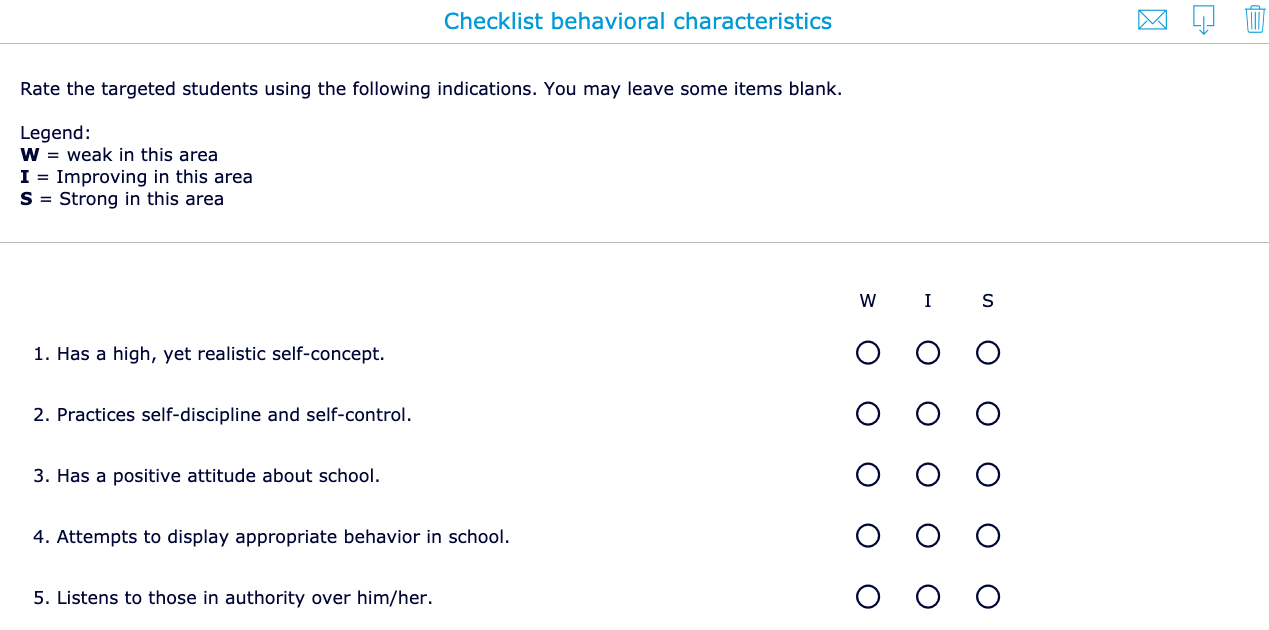What to do with underachieving students? A quick teacher guide
 Lucie Renard —
Lucie Renard —
Underachievement in education is a common problem. You’ve probably noticed yourself that it’s not always easy to get students motivated to learn, and that some students are not living up to expectations.
So how can you, as a teacher, solve this rather common problem? This post is all about understanding underachievement, identifying underachieving students, and helping those students reach their full potential again. You’ll find a lot of tips against underachievement, and insights that will help you out.
I’ll talk about the following topics:
- What is underachievement?
- Causes of underachievement
- Identifying underachievers
- Strategies for underachieving students
- Extra resources on motivating students to learn
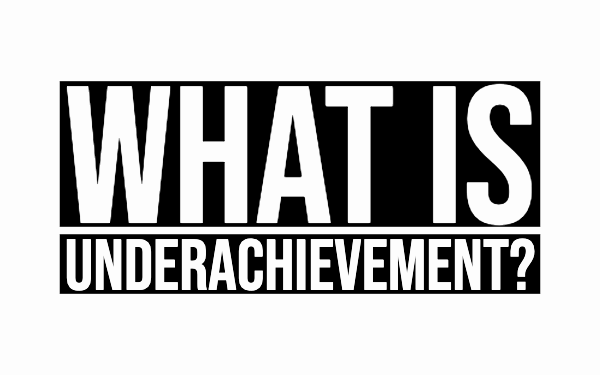
What is underachievement?
The definition of underachievement is: “Poorer than expected performance”.
In other words: you expect a student to accomplish good work in your classroom, as the student has all the capabilities. In reality, that student can’t live up to its own competences, and fails to deliver high quality work.
Other descriptions include:
“Underachievement is defined as a discrepancy between a child’s school performance and some index of his or her actual ability, such as intelligence, achievement, or creativity score, or observational data” - Davis and Rimm 1985
“A discrepancy between potential (what a child ought to be able to do) and actual performance (what a child is really demonstrating)” - Richert 1991
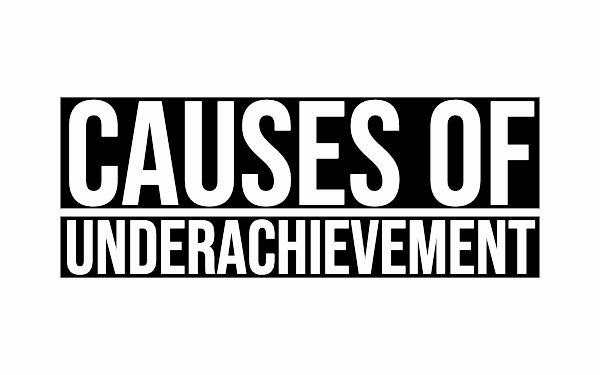
Causes of underachievement
There are many causes at the basis of student underachievement. Important causes are the ones that relate to the family and the community in which a student lives (environment and school).
Here are some important causes of underachievement in school:
- Fear of failure, fear of success
- Fear of lack of acceptance by peer group
- Undetected learning disabilities
- Lack of basic skills and study habits
- Inappropriate educational activities
- Lack of opportunity in society
- Too high or too low expectations of parents
- Lack of parental support for education
- Fear of overshadowing parent
- Passive-aggression toward parent
- Low frustration tolerance
- Lack of impulse control
- Low risk-taking abilities
- Lack of competitiveness - Boredom
- Guilt for being advanced intellectually
- Interests in activities other than school
- Cumulative deficits and belief in failure
When you find out what lies at the bottom of an underachieving student, you can start solving the problem. Be aware that you’re not a genie: it takes time to set up a working strategy for underachieving students. On top of that, every student will need a individualized learning plan.
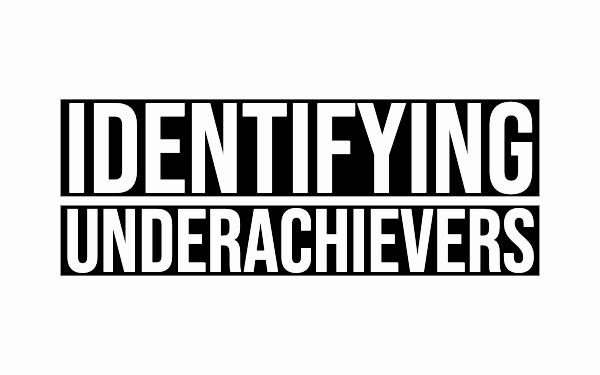
Identifying underachievers
Underachievement can be measured in many ways using a number of criteria. Here are some of the most known ways teachers usually use to identify underachieving students:
First, you could let your students complete an intelligence test to see whether a student how gifted a student is
Second: test your students in groups. When a pattern of continuous decline in group achievement test scores occurs, you can quickly identify an underachiever.
Last but not least: observe. As a teacher, you know your students best. You know how they normally behave and when their behavior changes.
The most important thing to remember here is that underachievement is a behavior. This means that it can be modified. So, the lesson here would be not to label the student as an underachiever, but to label the behavior itself. For example: the student is “underachieving in math and language arts” rather than an “underachieving student”. (DeLisle)
Characteristics of underachievers
Specific behaviors can be identified and targeted by using the behavioral characteristics checklist below.
Using this checklist (originally created by Carolyn Coil), you can also identify positive or negative behaviors.
Tech tip: Use BookWidgets to create checklists and worksheets like this yourself.
The checklist can be a huge help already. When observing students, there are some standard characteristics of underachievers you can pay attention to. Some of them are in the checklist already, but can’t be observed that easily. Best is to start a conversation with the student to find out what is bothering them.
Underachieving students:
- See themselves as inadequate
- Expect academic and social failure
- Feel helpless to control outcomes of effort
- Don’t feel free to make choices
- Set unrealistic goals
- Are defensive toward authority
- Feel rejected and isolated
- Are not willing to risk failure
- Show ineffective approaches to problems
It’s really important to distinguish achieving students from underachieving students. Although both students can be equally talented students, underachieving students have different characteristics than achieving ones:
- Lack of integration of goals & self-direction
- Lack of self-confidence
- Inability to persevere
- Inferiority feelings
- Social immaturity
- Emotional problems
- Antisocial behavior
- Low self-concept
- An unstable family environment
Underachiever profiles
According to Dr. Diane Heacox, there are 6 underachiever profiles a student can take. As a teacher, I’m sure they will sound rather familiar.
- The rebel: “Why should I play the school game?”
- The conformist: “Please, don’t notice that I am smart.”
- The stressed learner: “It’s not good enough.”
- The struggling students: “I just don’t get it.”
- The victim: “It’s not my fault”.
- The bored students “There’s nothing new to learn.”
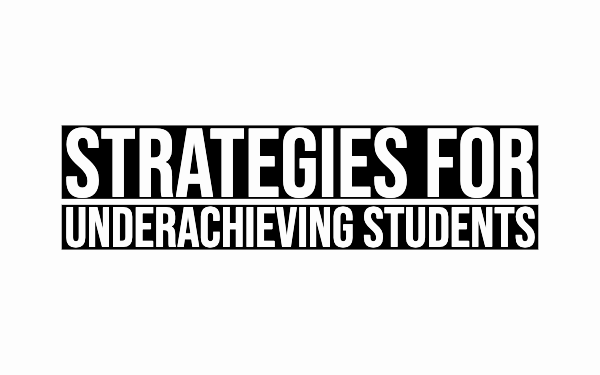
Strategies for underachieving students
Here are some strategies to support underachieving students. The first three underachievement strategies are well-known strategies suggested by Delisle and Berger.
Supportive strategies
These are classroom techniques and classroom designs that allow students to feel included. They feel part of a family instead of a factory.
Involve your students in making rules, taking important decisions, set up punishments and rewards together, discuss student concerns, create activities based on your students’ needs and interests, allow them to superiority (skip parts of an assignment) when they have previously shown competency, and so on.
Show them communicating with the teacher works in two ways.
Reward systems are often used in this strategy. Be aware of the disadvantages though!
Intrinsic strategies
Here, students have to be motivated intrinsically. You want your students to desire to achieve academically, without you telling them they should.
Once students want to follow their dreams or their own goals, students will work harder. If you lay your goals and your dream upon their shoulders, it won’t work.
Creating a classroom management that invites positive attitudes is likely to encourage achievement. In classrooms of this type, teachers encourage attempts, not just successes. A student that wants to learn is the best student you can imagine, even if learning doesn’t always go smoothly.
Another strategy is to allow students to evaluate their own work before receiving a grade from the teacher. Self-assessments reflect a student’s expectations of their work.
Here are some creative and fun self-assessment ideas.
Remedial strategies
Students are not perfect. Every student has their own strengths and weaknesses, as well as social, emotional and intellectual needs.
Use remedial teaching methods to give students a chance to excel in their strengths and interests. Provide opportunities in specific areas with learning difficulties (think about remediation exercises).
The remediation must be done in a safe environment in which mistakes are considered a part of learning. Teach your students the value of getting up after a knock-out. They will learn from it and do better the next time. Failure leads to student success.
Choose for a BookWidgets Planner to set up learning activities based on a single student. This “widget” (or exercise) has many possibilities. You can let your student choose between remediation activities or give him a list of activities he has to complete. Check out this webinar to discover the power of the planner widget.
The 5 C’s
When you have a “bored student” in front of you, there’s a simple strategy to keep him engaged: The 5 C’s – Control, choice, challenge, complexity and caring.
- Control: Give bored students control over what they learn. This means that they work best independently.
- Choice: Give the students a choice of what they learn. Give them a range of exercises they can choose from. When doing a book review, let them choose the book, or let them come up with a list of books you can review and accept.
- Challenge: Challenge them to do things they are not used to do. Be more creative, give them an extra challenge, and reward them when they found a solution to this “impossible” challenge. They still have the choice not to do this.
- Complexity: Don’t make things too easy. If a problem is interesting, a student will be more likely to solve it. Solving complex challenges triggers a students interest if he knows basic knowledge. Be aware though: if the problem is too hard, there’s no pleasure in solving it.
Focus on strength
It’s important for the teacher to focus on the strength of the students. This goes both ways: the student also has to acknowledge their strengths.
Create challenging activities, variety, and opportunity for students to utilize their strengths and interests so they can improve their performance and facilitate in-depth learning.
As you know, successful experiences (like being able to solve a problem) lead to success. Encourage your students to go from a fixed mindset to a growth mindset.
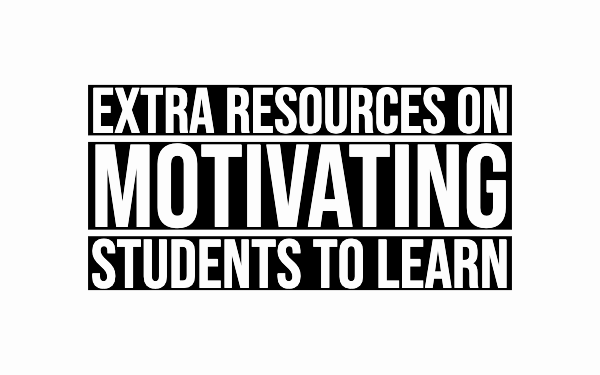
Extra resources on motivating students to learn
“The brain is not designed for thinking, it’s designed to save you from thinking.” Daniel T. Willingham.
So, how do you further motivate students to learn?
I summarized the book “Why don’t students like school” from Daniel T. Willingham. The blog post series will help you figure out how a student thinks and what it means for your classroom. You should really read them all, but for this post about helping underachieving students, part 1 and part 5 will be more on topic.
- Part 1: Why don’t students like learning
- Part 2: How can you teach students the skills they need when standardized tests require only facts?
- Part 3: Why is it so hard for students to understand abstract ideas?
- Part 4: Is drilling worth it?
- Part 5: How can I adjust my teaching for different types of learners?
As you know now, lack of basic skills and study habits is an important cause of underachievement. In order for your students to learn in an effective way, you could teach them the most effective learning strategies.
Wrap up
As you can see now, talented underachievers need a different approach. They are not your typical learners. I hope this short guide with tips for underachieving students helps you to change your teaching so that everybody can thrive in your classroom.
Did this guide help you? Let us know on Twitter and join our Teaching with BookWidgets Facebook community to share your BookWidgets lessons with other teachers. And don’t forget to say hi 👋 and connect with me on LinkedIn or Twitter.
